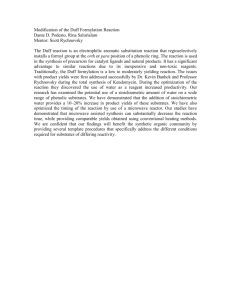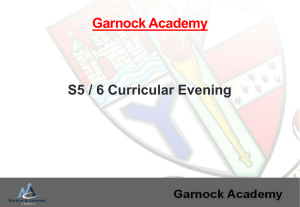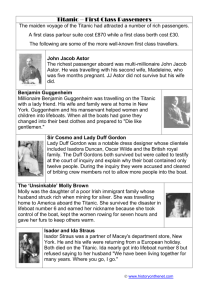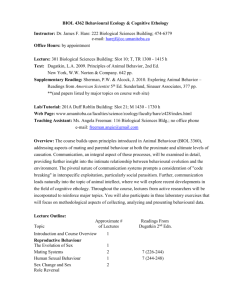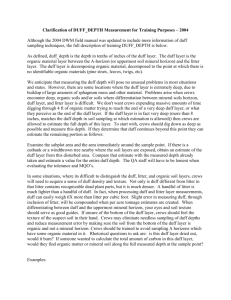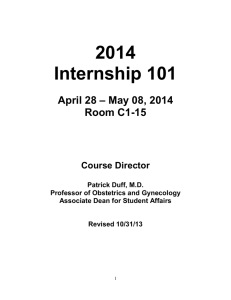Newsletter 22 - Entomology Research Museum
advertisement
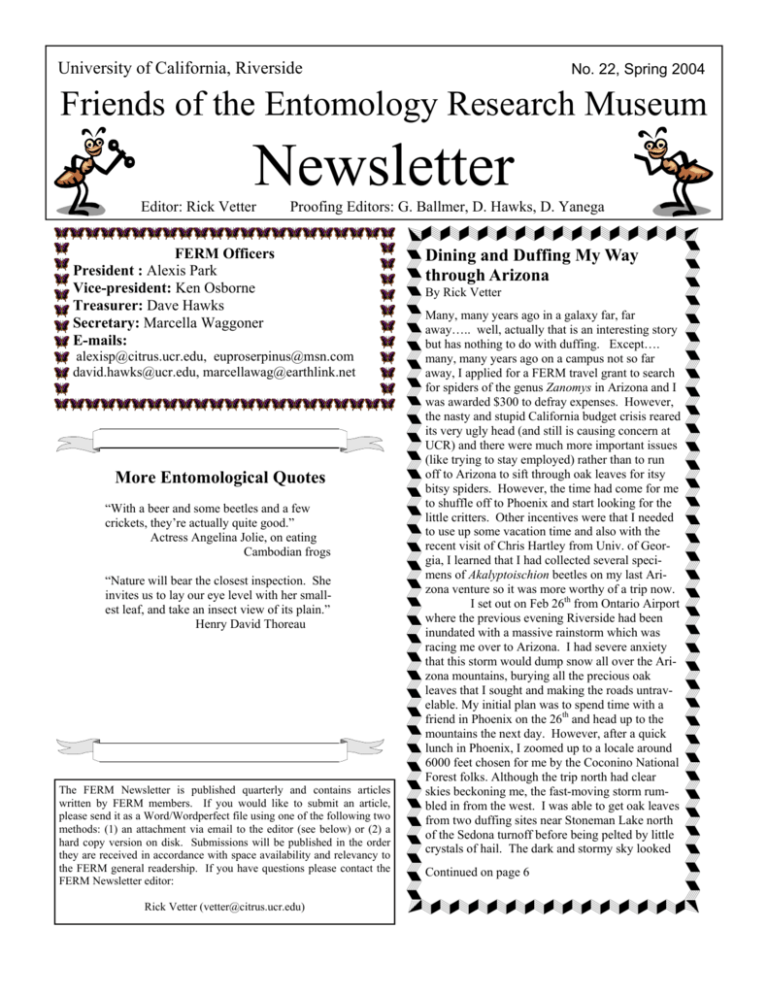
University of California, Riverside No. 22, Spring 2004 Friends of the Entomology Research Museum Newsletter Editor: Rick Vetter Proofing Editors: G. Ballmer, D. Hawks, D. Yanega FERM Officers President : Alexis Park Vice-president: Ken Osborne Treasurer: Dave Hawks Secretary: Marcella Waggoner E-mails: alexisp@citrus.ucr.edu, euproserpinus@msn.com david.hawks@ucr.edu, marcellawag@earthlink.net More Entomological Quotes “With a beer and some beetles and a few crickets, they’re actually quite good.” Actress Angelina Jolie, on eating Cambodian frogs “Nature will bear the closest inspection. She invites us to lay our eye level with her smallest leaf, and take an insect view of its plain.” Henry David Thoreau The FERM Newsletter is published quarterly and contains articles written by FERM members. If you would like to submit an article, please send it as a Word/Wordperfect file using one of the following two methods: (1) an attachment via email to the editor (see below) or (2) a hard copy version on disk. Submissions will be published in the order they are received in accordance with space availability and relevancy to the FERM general readership. If you have questions please contact the FERM Newsletter editor: Rick Vetter (vetter@citrus.ucr.edu) Dining and Duffing My Way through Arizona By Rick Vetter Many, many years ago in a galaxy far, far away….. well, actually that is an interesting story but has nothing to do with duffing. Except…. many, many years ago on a campus not so far away, I applied for a FERM travel grant to search for spiders of the genus Zanomys in Arizona and I was awarded $300 to defray expenses. However, the nasty and stupid California budget crisis reared its very ugly head (and still is causing concern at UCR) and there were much more important issues (like trying to stay employed) rather than to run off to Arizona to sift through oak leaves for itsy bitsy spiders. However, the time had come for me to shuffle off to Phoenix and start looking for the little critters. Other incentives were that I needed to use up some vacation time and also with the recent visit of Chris Hartley from Univ. of Georgia, I learned that I had collected several specimens of Akalyptoischion beetles on my last Arizona venture so it was more worthy of a trip now. I set out on Feb 26th from Ontario Airport where the previous evening Riverside had been inundated with a massive rainstorm which was racing me over to Arizona. I had severe anxiety that this storm would dump snow all over the Arizona mountains, burying all the precious oak leaves that I sought and making the roads untravelable. My initial plan was to spend time with a friend in Phoenix on the 26th and head up to the mountains the next day. However, after a quick lunch in Phoenix, I zoomed up to a locale around 6000 feet chosen for me by the Coconino National Forest folks. Although the trip north had clear skies beckoning me, the fast-moving storm rumbled in from the west. I was able to get oak leaves from two duffing sites near Stoneman Lake north of the Sedona turnoff before being pelted by little crystals of hail. The dark and stormy sky looked Continued on page 6 NEWS FROM THE MUSEUM by Doug Yanega, Senior Museum Scientist The winter quarter has been a little slow, but a few significant things have happened: (1) we've gotten all of the undetermined Orthoptera sorted out (thanks to Jeremy Allison), and gotten about 10 drawers of miscellaneous insects (mostly bees and wasps) sorted out (thanks to Sarah Butler), (2) we've made some real headway with a databased inventory of our bulk samples in alcohol (thanks to Katie Poole), (3) in collaboration with Mike Allen's lab, we've got a new data entry person, Nhi Vu, working diligently on the Deep Canyon material, and (4) John Luhman recently visited and sorted out several drawers of undetermined Braconid wasps, to subfamily or genus, which will get a lot of this material into circulation, given that there's an active group of Braconid taxonomists looking for material. The Museum's regular database has grown to over 57,000 specimens, and the authority file now has over 142,000 species names (the world species list of ants - nearly 15,000 names - was just added) and almost 23,000 genera. The world catalog of Sphecid wasps (from Wojciech Pulawski's website at the CNAS) should be the next major addition, with over 9,000 species. Given that the coming field season looks promising, we may have a lot of nice collected material coming in over the next several months, as we did last year. Time to brush off the cobwebs and get out the nets, pan traps, and MV lights! Got an idea for a FERM article??? Do you have anything buggy-related that might be of interest for the FERM newsletter? We really would be tickled pinkish if you would send “stuff” in. Remember, this newsletter won’t have much in it unless we have material submitted from you folks that we can publish. Feel free to send in photos, articles, recent publications related to insect taxonomy or natural history and even stories about how the Entomology Research Museum has assisted you in your bug-related endeavors. Send them to vetter@citrus.ucr.edu, preferably as attachments (not in email text). Additional information is on the front page of this newsletter. **Deadline for submission of material for next Newsletter is Jun 15th** Can you identify these famous Inland Empire scientists? The person on the left with the hat is Edmund Jaeger, well known local scientist who wrote much about the desert and had palavers in the wild. The person on the right is none other than FERM’s own Oscar Clarke in his pre-Gandalf days. Correct answers were offered by: Gene Drake (a fossil), Saul Frommer (a fossil), Bob Orth (another fossil), Dave Hawks (for all intents and purposes, also a fossil), Report on the FERM Annual Meeting By Alexis Park I begin my duties as the new FERM President with this scintillating account of the Annual Meeting that was held on the last day of January 2004. Having experienced only two Annual Meetings thus far (including this one), I don’t exactly have a broad basis for judgment, but it was pretty clear that everybody had a really good time. Fifty-one members of FERM attended the Annual Meeting this year. We are greatly obliged to Gordon Pratt and Cissy Pierce for the marvelous spread of Asian-themed food that quite deservedly received everybody’s undivided attention at the beginning of the meeting. It would be a disservice for me to attempt to name and describe all of the many wonderful dishes present that evening, so I will bow out with the overused: “You had to have been there.” It really was an excellent meal. Digestion of the sumptuous repast was aided by the music of the Rondalla Ensemble, a Philippine musical troupe, which provided sprightly airs and folk songs as a pleasant background to the otherwise monotonous sound of busy jaws masticating in the night. Our featured speaker was UCLA Professor Dr. Henry Hespenheide. Dr. Hespenheide’s presentation was titled “Collecting in Collections: Mimicry and Museums.” The bulk of Dr. Hespenheide’s talk was related to his research in evolutionary ecology and biodiversity in Neotropical wet forests. Perhaps the most relevant point of Dr. Hespenheide’s talk was reminding us exactly what a wealth of information is held within collections, including our very own UCR insect collection. Being an avid collector of beetles, it is clear to me that no matter how long I spend collecting in a given area (even a small one), there are always specimens that escape my notice. Museums are invaluable repositories of the effort of multiple collectors, over different ranges of time, using different methods, etc. Our members should be proud of the fact that they haven’t lost sight of why “a room full of bugs” is something worthy of our attention and time. Although Rick Vetter was not available to run our book auction in his usual stentorian style, we managed to pull in a nice $132. We have our new Vice-President, Ken Osborne, to thank for a significant portion of this: in sales, not auctioning! There were a rather large number of door prizes and almost half the group came away with something this year. Also, the “two-headed Dynastes granti” featured in the last newsletter was brought in by Elois Hawks to shock and amaze. If you weren’t there, you missed out on a lot of good times, good food, and your recommended allowance of FERM strangeness. Hope to see you next year! Friends of the Entomology Research Museum Membership Form Check here if you are renewing (renew by July each year) Name ________________________________________________________________________ Address ______________________________________________________________________ Interests ______________________________________________________________________ Telephone ___________________________Email_____________________________________ MEMBERSHIP CATEGORIES: Basic Membership Sustaining Member Donor Benefactor Patron $10.00 $25.00+ $100.00+ $500.00+ $1000.00+ Please Check Submit your membership form and dues to: David C. Hawks, Treasurer Friends of the Entomology Research Museum Department of Entomology - 041 University of California Riverside, CA 92521-0314 Dues and other contributions are payable by check to the UCR Foundation, noting “Entomology Museum” on the memo line on your check. (It is very important to note “Entomology Museum” in order for your donation to be deposited in the Friends’ UCR Foundation account.) Latridiids in a Haystack, or a Beetle in the Duff by Chris Hartley, Department of Entomology, University of Georgia Recently, I was privileged to spend some time collecting in the mountains surrounding Riverside. I embarked upon the trip to gather material for my Master’s research at the University of Georgia, but the pursuit I was undertaking was nothing less than a searching for the proverbial needle in the haystack, the diamond in the rough, the beetle in the oak duff. I was after beetles of the genus Akalyptoischion, a group of exceedingly small beetles in the family Latridiidae. They are presently known only from the Western United States with only one species that has ever been recorded outside of California and Arizona, but they may be locally abundant where they are found. The eight known species are extremely isolated geographically with little overlap among their ranges. These records are probably due in part to the fact that relatively little litter sampling has been done in suitable habitat, and increased sampling may fill in some of the gaps between species ranges. Like all latridiids, species of Akalyptoischion are fungus feeders, and they are found in leaf litter where they feed on the soil fungi. They are most commonly collected from oak duff though records from other types of litter have been noted. They are almost never found in extremely wet or extremely dry litter but rather in litter that is nicely moist. A nearby water source, even a creek that runs dry for part of the year, is probably an important part of their habitat. They have also been taken with great frequency by extracting the leaf litter beneath nests of the wood rat, Neotoma. I want to share the experience of what it is like to wander through the forest searching for brown, non-descript beetles that live beneath the leaves and rarely exceed one millimeter in length. The quest can at times seem like madness itself, but the rewards of diligent searching are considerable and abundant. You grab handfuls of duff from the often frozen ground, hoping that the one thing for which you are searching will be found within, but never able to visually confirm what you are catching until you return to the lab. The excitement of what each sample could contain makes up for any frustrations involved in collecting them. There is a world in the leaf litter that few have ever explored. It is an undiscovered country right here in front of each of us that is teeming with rarely seen or entirely new species of insects and other arthropods as well as diverse other life forms. The little creatures that live in the leaf duff offer us proof of life’s immense variety and show us that we sometimes need look no further than our own back yards to find wonderful things. So I explored the mountain areas around Riverside looking for suitable habitat for these elusive beetles. I went to the Cedar Springs trail and up to Angelus Oaks. I went to several likely spots in the Cleveland National Forest and explored the area around Millard Canyon and the Kitching Peak trail. What I discovered from all my sampling was the true meaning of endemism. Akalyptoischion exists in severe isolation. In most of my sampling, other genera of latridiids were common while Akalyptoischion remained conspicuously absent. When they were found, it was within the microhabitat of oak trees growing on a slope with rocks placed such that litter accumulates into thick piles behind them. These areas of thick litter that can support rich fungal growth seem to be most favored by latridiids. Conversely, an extremely thick fungal mat under the leaves seems to discourage the beetles from moving in. I had most success at areas above 5000 ft, probably due to the fact that these areas remain moist year round while lower elevations dry out in the hotter months. By all appearances, it seems that Akalyptoischion is simply rare and sparsely distributed. The exact reason for their apparent scarcity may not be so mysterious, though, as drought, type of litter, amount of moisture in the litter, elevation, and other factors may all be directing their distribution. My trip gave me several good insights into the world beneath the leaves that Akalyptoischion inhabits, and only by continuing to sample in probable habitats will we be able to determine the range, habitat, and abundance of Akalyptoischion. I was very generously assisted during my visit by Rick Vetter and Gene Drake who accompanied me to collecting sites and provided some of their samples for my perusal, and by Doug Yanega, who provided generous help with specimens at the Museum. Thank you everyone! Akalyptoischion tomeus (life-size) (Okay not really. Actually about 1mm) Editor’s note: We have a lot of FERM folks out there who are processing oak leaf duff for spiders, beetles, wasps, etc. If you run into little beetles like the image presented here, Chris would be very pleased to receive more specimens from wherever they can be collected. Several of us have Chris’ contact information if you run across critters that you think might be latridiids. They have a 3-3-3 tarsal pattern which is diagnostic for the family. Recent Publications by FERM members: Ballmer, G. R. 2003. Observations on resource partitioning among ants (Hymenoptera: Formicidae) and lycaenid larvae (Lepidoptera: Lycaenidae) associated with Pueraria phaseoloides in South Thailand. Science Asia 29: 197-202. Buffington, M. L. 2004. The description of Preseucoela Buffington, new genus, with notes on the status of Nearctic species of Agrostocynips Diaz (Hymenoptera: Figitidae: Eucoilinae). Zootaxa 408:1-11 Buffington, M. L. 2004. Taxonomic notes on Nordlandiella Diaz and Ganaspidium Weld (Hymenoptera: Figitidae: Eucoilinae). Proc. Entomol. Soc. Wash. 106:192-198 Burks, R. 2004. Dermatopelte Erdös & Novicky (Hymenoptera: Eulophidae) newly recorded for the Nearctic region, with description of two new species. Zootaxa 407:1-10. Heraty, J. 2004. Molecular Systematics, Chalcidoidea and Biological Control. pp. 39-71, In: Genetics, Evolution and Biological Control, ed: L. E. Ehler, R. Sforza, T. Matreille. CAB International. Logarzo, G., Triapitsyn, S. V. & W. A. Jones. 2003 (2004). New host records for two species of Gonatocerus (Hymenoptera: Mymaridae), egg parasitoids of proconiine sharpshooters (Hemiptera: Clypeorrhyncha: Cicadellidae), in Peru. Florida Entomologist 86 (4): 486-487. Riefner, R. E. Jr., G. F. Pratt and R. J Shlemon. 2002. A rare soil lichen, an endangered butterfly, and open habitat soils: interacting components requiring protection in southern California. Crossoma 28:1-8. Triapitsyn, S. V. 2002. Species-level taxonomy of Mymaridae (Hymenoptera): current status and implications for biological control of leafhoppers of economic importance, pp. 89-94. In: Melika, G. & Thuróczy, C., editors. Parasitic wasps: evolution, systematics, biodiversity and biological control. Agroinform, Budapest, 480 pp Triapitsyn, S. V. 2003. Description of a new species of Anagrus from China related to A. takeyanus (Hymenoptera Mymaridae). Belgian Journal of Entomology 5 (1-2): 117-124. Triapitsyn, S. V. 2003. A note on the status of Gonatocerus cicadellae Nikolskaja, 1951 (Hymenoptera: Mymaridae). Russian Entomological Journal 12 (2): 211-212. Triapitsyn, S. V. 2003. Taxonomic notes on the genera and species of Trichogrammatidae (Hymenoptera) - egg parasitoids of the proconiine sharpshooters (Hemiptera: Clypeorrhyncha: Cicadellidae: Proconiini) in southeastern USA. Transactions of the American Entomological Society 129 (2): 245-265. Triapitsyn, S. V. 2003. Review of the Mymaridae (Hymenoptera, Chalcidoidea) of Primorskii Krai: genus Erythmelus Enock. Far Eastern Entomologist 126: 1-44. Triapitsyn, S. V., D. J. W. Morgan, M. S. Hoddle & V. V. Berezovskiy. 2003. Observations on the biology of Gonatocerus fasciatus Girault (Hymenoptera: Mymaridae), egg parasitoid of Homalodisca coagulata (Say) and Oncometopia orbona (Fabricius) (Hemiptera: Clypeorrhyncha: Cicadellidae). Pan-Pacific Entomologist 79 (1): 75-76. IF YOU ARE A MEMBER OF FERM AND HAVE RECENT PUBLICATIONS THAT INVOLVE ARTHROPOD TAXONOMY OR NATURAL HISTORY, PLEASE SUBMIT THE CITATION TO RICK VETTER. angrier than a bulldog with a mouthful of hornets so I quickly skedaddled out of there and headed back down I-17 for lower and less hostile elevations. As I drove south, the skies lightened even though the night approachethed (isn’t that just sooooo poetic?). I stopped at one more site south of Camp Verde to find a scrub oak in the midst of a semi-desert flora because sometimes these marginal or transitional habitats can yield some very different and interesting spiders. The next day was spent in the back yard at my friend’s house where all day I sifted through my bags o’ duff, while she ran around Phoenix doing her typical harried mom-of-two-teenagers routine. Spider sifting was interrupted by lunch at a very nice nearby restaurant and then dinner at a Greek place owned by a friend of hers. My friend Mary and I share cooking interests so she made sure that she took me to major “foodie” venues. At a bistro, I had a wonderful set of 4 bruschetta appetizers (bread topped with goat cheese-roasted red bell peppers or sliced apple-baked brie or minced marinated artichoke hearts or prosciutto with mascarpone and figs. At a different lunch, I had a red bell pepper, goat cheese and oyster mushroom pizza with an appetizer of prosicutto-wrapped asparagus. Very nice. Saturday morning I shuffled out of Phoenix, heading east to Globe (4000 feet) which is cold and windy in the winter with the air decidedly nippish. Three years ago, I did a short vacation there and was enjoying the view of an overlook of a nearby canyon and happened to notice an oak tree on the ridge. Although I grabbed a mere 2 gallons of duff that time, I ended up with 4 specimens of Zanomys, possibly an undescribed species and also unbeknownst to me until Chris Hartley’s Xmas 2003 visit, 4 Akalyptoischion beetles. So I had a double incentive to go back to the very same overlook and grab some more duff. Heading north from Globe to this hallowed site, I once again noticed the intermittent cumulus clouds that were mosaic-ing their way across the sky like a patchwork quilt. I drove to the overlook hoping to find the Holy Grail of the Oak Tree. When I got there, I looked around and there was only one oak on the ridge so that musta been it. I grabbed some duff and headed back south, planning to stop at some choice duffing spots that I spied on the way up. The elevations of these areas varied from 4000 to 5600 feet so it was fairly high up there. However, the mosaic clouds became more of a continuous tapestry weaving a bit too much dark gunmetal grey as a theme. As I was grabbing oak leaves from a really nice thick carpet of duff, I started getting pummelled with snow. Considering that I was about 30 minutes up the mountain, I figured that it might be best to get my butt out of there in case the snow was worse south of me. However, my hyperparanoid New Yorker anxiety level (Doug Yanega will understand) was unfounded. As I headed south to a slightly lower elevation, the snow abated to a gentle shower and the sun became more prominent. However, there were valleys to the west of the highway that were obviously getting a good dusting. Back to Globe and lunch at a great Mexican restaurant that is the ultimate dive. Cinder block building, cramped seating, ripped seat covers, ugly artwork on the walls, waitresses who looked like they could have dated Pancho Villa, great salsa, tasty food and pleasant service. After lunch, I headed to an area in the Tonto National Forest just outside of the Globe “city” limits. This area was picked out for me by the Forest Service people because it had some nice stands of oaks. At one clearing near the entrance to the place, I grabbed some rather unproductive looking duff (small shrubs, thin duff laying, duff not decomposing so there was little spider prey like collembolans). Then I went up to Icehouse Canyon Picnic area which was nicely festooned with tall and copious oak trees and picnic tables where I could duff away to my heart’s content (or at least till dark) and toss the leaves right back into the weeds. I was happily duffing my two bags and was surprised that the duff from the lean area actually had more spiders and more diversity. The picnic area had an onsite “host” who lived there during the winter to watch over the place. After I was duffing for about 2 hours, sitting at the table intently squinting at my little piles of sifted organic material, the host came over to see if any of my “gold sifting” was productive. I found out that he lives in Wyoming and comes down for the winters to escape the snow although he wasn’t necessarily escaping the winter because it was 4500 feet there and cold. He was rather fascinated by my quest for little spiders and sat there for about 45 minutes helping me by pointing out little moving critters in the duff. And very amusingly as happens many times no matter where I go, once he learned about my spider interests, he started into a discussion about how his wife got bit by a brown recluse. Wellllll, we ALL know how quickly his part of the conversation was terminated and what happened for the next 10 minutes or so. I must be getting better at this stuff because he immediately was able to be convinced that his doctor was wrong and that I knew my stuff. Very amusing. Another convert. Anyway, Icehouse Canyon lived up to its name, because around 3:30 pm as I was finishing up with the sifting of my last few batches, snow started to fall which made it nearly impossible to look for spiders. I spot them by their movement in the sifted duff on a canvas beating sheet and having 10 or so snowflakes landing on the sifted oak leaves every second, created a serious visual background noise problem. Considering that I am looking for dark spiders on brown duff siftings, having highly contrasting white particles bouncing across the duff made the spider seeking pretty much a wasted effort. Not to mention that there was a fairly consistent wind blowing all day such that I was wearing my rain pants and rain parka to cut the chill. So I was glad that I was running out of local duff (still having about 7 non-local bags in my car trunk). I left the park and went over to check in at the Noftsger Hill Inn, a bed-and-breakfast that used to be an elementary school. The room I had last time was a former classroom with 20 foot ceilings and more square footage than my apartment. This time I had a smaller, cheaper and more efficient room (it used to be the janitor’s room) that was more suitable to a traveling duffing scientist than a tourist. I even turned off the heater in the room to make it seem less like a vacation. Dinner that night was in a local country club where the chefs had graduated from the Scottsdale Culinary Institute. The bread was fresh and wonderful, the herbed butter was delicious as was the rack of lamb with mint glaze. Home again after dinner, into my ultracomfy pile pants and sweatshirt whereupon I am typing this portion of the story to you whilst sitting in front of a propane-fired fireplace in what used to be the spacious main hallway of the elementary school with the occasional company of an overweight black cat who has learned that lying in front of the fireplace is a good thing to do on a cold evening. Sunday AM: leaving Globe and heading south to Tucson, I passed many majestic oaks on Highway 77, information which I will store for future reference. I already had 7 bags of duff in my trunk as I headed to the home of an arachnologist friend to whom I had already sent one of my Berlese funnels. I didn’t want to grab any more duff along the way because I didn’t think that I would have time to sift through the stuff anyway. In Tucson, I pretty much hit the ground running spending all day in my friend’s backyard sifting through duff. Dinner on Sunday night was a hazelnut encrusted trout with a shrimp-corn sauce and garlic mashed taters and Monday was sushi. Lunch on Tuesday was cilantro creamstuffed chicken with beurre blanc. All of Monday was spent sifting through the remnants of the duff, running duff through the Berlese, looking at alcohol samples, sorting the specimens, cleaning up and putting everything away. Tuesday it was back to Phoenix where I spent the evening in the home of Dr. David Swanson, a dermatologist from the Mayo Clinic. In the summer of 2003, he contacted me in regard to a brown recluse manuscript that he was writing. I made so many contributions, changes, suggestions, re-writes, etc, that he put me on the paper as second author. We actually got it past the first hurdle at the ultra-snooty New England Journal of Medicine which was a feat in itself. We are still hoping that it might be accepted after review there but aren’t getting our hopes up. However, not many manuscripts from the Arizona clinic get an invitation to be submitted to this prestigious (and also pompous) journal so the Mayo staff is very hopeful about the chances so far. Anyway, I spent the evening discussing spiders and necrotic skin lesions and basically, corrupting and undoing all the training of their 6-month old Bichon Frisee puppy that they are trying to make socially acceptable. All in all, it was a somewhat disappointing trip. I did get one female of Zanomys kaiba at the Stoneman Lake area and, near Globe at a second site, I got 3 females of an undescribed species of Zanomys (unless it is a variant of one of the known species – I will need to find males to determine this for sure). I did get a few parasitic waspies for UCR waspie freaks (of which there are many) and a few interesting beetles but no Akalyptoischion. However, the diversity and abundance of critters in the duff was uniformly sparse, much less so than I am used to in southern California. There weren’t even many collembolans in the duff which is always a bad sign. I didn’t process much duff through the Berlese funnel because it just didn’t seem to be worth the effort. Running a batch through for 2 to 3 hours would yield a beetle and an immature spider. Therefore, I didn’t see that it was a useful task considering that I had processed nearly 100 gallons of duff and got almost nothing whereas last time, I processed about 5 gallons of duff and got very interesting stuff. Anywho, I plan to return to Arizona in October or so. They get lots of summer rain in August and September so possibly their spider season starts much earlier in the year than it does in southern California. One silver lining from this trip is that by not getting copious quantities of new species of Zanomys, I will be able to start writing up the genus revision sooner. One of the “fears” of being overly successful in Arizona was that I would run into lots of new undescribed species and only get one of the sexes and therefore have to spend much more time collecting in a remote area far from Riverside. Possibly if I can find the male of the Globe species on the next trip, I will then call it quits on the Zanomys collecting and then concentrate on the manuscript. PINE : PARTNERS IN NATURE EDUCATION FERM members are entitled to 20% discounts* on the following UCR Extension field nature study courses: A Field Study of Birds: Spring Tue. 7:30-9:30 pm, Apr. 13/Field trips all day Sat. Apr. 17, 24, May 1, 15, June 5. $185 (34P23) Flora of Joshua Tree National Park: Wildflowers Fri. 6-9 pm, Apr. 23/Sat. 8 am-4 pm, Apr. 24/Sun. 8am-12 pm, Apr. 25. (Enroll through the Desert Institute, 760-367-5535) Field Study of the San Andreas Fault: San Bernardino to Palmdale Sat. 8 am-5 pm, May 1. $95 (EDP 34N31) Birds of Joshua Tree National Park Fri. 6-8 pm, May 7/Sat. 7:30 am-4 pm, May 8/Sun. 7am-12 pm, May 9. (Enroll through the Desert Institute, 760-367-5535) Natural and Cultural History of the Mojave National Preserve: Soda Lake to Kelso Dunes --The Low Country Fri. 8-10 pm, May 14/Sat. 8 am-5 pm, May 15/Sun. 8am-3 pm, May 16. $265 (34N32) Geology and Natural History of the Eastern Sierra Sat., Sun. 8 am-5 pm, May 22, 23. $150 (EDP 34N22) For current listing of courses at any time, bookmark www.unex.ucr.edu/ns/fns1/classes in your web browser. For further information, contact: Natural Sciences UCR Extension 909.787.5804 909.787.2456 (fax) *some restrictions apply Porcu’s Views Here is the latest installment from early-instar entomologist, Zac Porcu.
